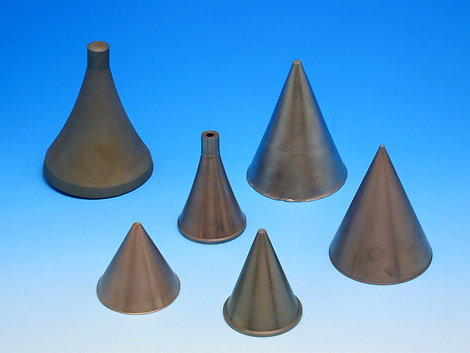|
What is Shaped Charge Liners?
A shaped charge is an explosive charge shaped to focus the effect of the explosive's energy. Various types are used to cut and form metal, initiate nuclear weapons, and penetrate armor. A typical modern lined shaped charge can penetrate armor steel to a depth of 7 or more times the diameter of the charge's cone (cone diameters, CD), though greater depths of 10 CD and above are now feasible.
The shape most commonly used for the liner is a cone, with an internal apex angle of 40 to 90 degrees. Different apex angles yield different distributions of jet mass and velocity. Small apex angles can result in jet bifurcation, or even in the failure of the jet to form at all; this is attributed to the collapse velocity being above a certain threshold, normally slightly higher than the liner material's bulk sound speed. Other widely used shapes include hemispheres, tulips, trumpets, ellipses, and bi-conics; the various shapes yield jets with different velocity and mass distributions.
Liners have been made from many materials, including glass and various metals. The deepest penetrations are achieved with a dense, ductile metal, and a very common choice has been copper. For some modern anti-armor weapons, molybdenum and pseudo-alloys of tungsten filler and copper binder (9:1 thus density is ~18t/m3) have been adopted. Just about every common metallic element has been tried, including aluminium, tungsten, tantalum, depleted uranium, lead, tin, cadmium, cobalt, magnesium, titanium, zinc, zirconium, molybdenum, beryllium, nickel, silver, and even gold and platinum. The selection of the material depends on the target to be penetrated; for example, aluminium has been found advantageous for concrete targets.
Why Choose Tungsten Alloy Products?
For the deepest penetrations, pure metals yield the best results, because they display the greatest ductility, hence postponing the breakup of the stretching jet into particles. In charges for oil-well completion, however, it is essential that a solid slug or "carrot" not be formed, since it would plug the hole just penetrated and interfere with the influx of oil. In the petroleum industry, therefore, liners are generally fabricated by powder metallurgy, often of pseudo-alloys, which if un-sintered, yield jets that are composed mainly of dispersed fine metal particles.
During World War II, liners were made of copper or steel, though other materials were tried or researched. The precision of the charge's construction and its detonation mode were both inferior to modern warheads. This lower precision caused the jet to curve and to break up at an earlier time and hence at a shorter distance. The resulting dispersion decreased the penetration depth for a given cone diameter and also shortened the optimum standoff distance. Since the charges were less effective at larger standoffs, side and turret skirts fitted to some German tanks to protect against Russian anti-tank rifle fire were fortuitously found to give the jet room to disperse and hence reduce its penetrating ability.
The use of skirts today may increase the penetration of some warheads. Due to constraints in the length of the projectile/missile, the built in stand-off on many warheads is not the optimum distance. The skirting effectively increases the distance between the armour and the target, providing the warhead with a more optimum standoff and greater penetration if the optimum stand-off is not drastically exceeded. Skirting should not be confused with cage armour which is used to damage the fuzing system of RPG-7 projectiles. The armour works by deforming the inner and outer ogives and shorting the firing circuit between the rocket's piezoelectric nose probe and rear fuze assembly. If the nose probe strikes the armour, the warhead will function as normal.
The spacing between the shaped charge and its target is critical, as there is an optimum standoff distance to achieve the deepest penetration. At short standoffs, the jet does not have room to stretch out, and at long standoffs, it eventually breaks into particles, which then tend to drift off the line of axis and to tumble, so that the successive particles tend to widen rather than deepen the hole. At very long standoffs, velocity is lost to air drag, degrading penetration further.
Tungsten alloy is a suitable material for shaped charge liners. So if you have any interest in this product, please feel free to email us: sales@chinatungsten.com or call us by: 0086 592 512 9696, 0086 592 512 9595.

|


